Javascript Fundamentals
Welcome to the next instalment of my technical series of blogs. Today I’m going to be writing about Javascript.
Javascript is a programming language unlike HTML and CSS. If we consider HTML as the foundation and framing of a house and CSS as the internal styling of the house then we can consider Javascript as being the functions in the house, or what you can do in the house. You can change the way the house functions. For e.g if your house is already built then you can use Javascript to alter the house after it’s already been built. Similar to a renovation! But you can go as far as altering the foundations and styling of the house after it’s already been built, or you can even use Javascript to build the entire house from scratch if you please! If you change your mind you can once again change it dynamically. For e.g if your house was already built but you don’t like wall between your kitchen and your living room then tear it down with Javascript! It’s essentially renovating but you’ve got some of the best tools in the world to work with and it’s only a matter of your own imagination for what your house looks like and functions are like in the end.
So as I’ve explained, Javascript can allow you to change the fundamentals of the house and bring life to it. The possibilities are almost endless. It gives a lot of flexibility whereas HTML and CSS are a bit more rigid and don’t allow for much dynamic change.
These changes are done using what we call the DOM or Document Object Model. The browser allows us to access and use various datapoints on websites. Using these datapoints we can change the way the website functions/looks. For e.g say you want to change the colour of the background when a user clicks on the page. Well, you could insert a piece of code that attaches to a datapoint in the DOM that changes the background based on the user clicking the mouse. As seen below.
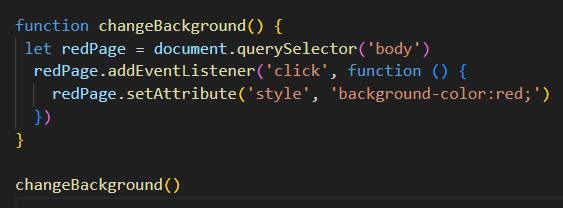
In this instance, upon clicking within the body area of the website, the page will turn from the default white to red. That’s not the most exciting thing to demonstrate but this just goes to show the functionality of Javascript. What this Javascript code has done is it has taken the HTML code using the DOM and added a style attribute with background-color: red. This code dynamically changed the code of the HTML and inserted it in when a click event happened on the body of the page.
See the HTML code change as soon as I clicked within the website.
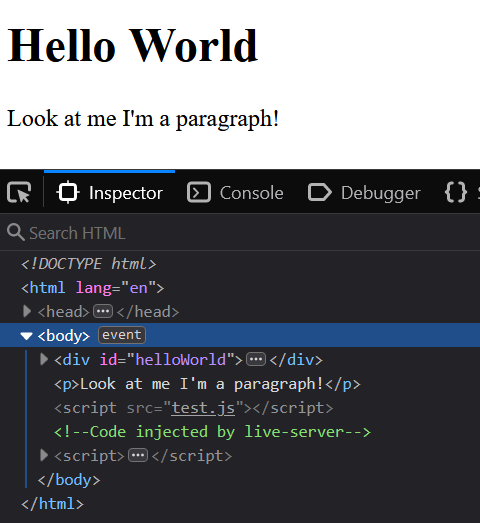
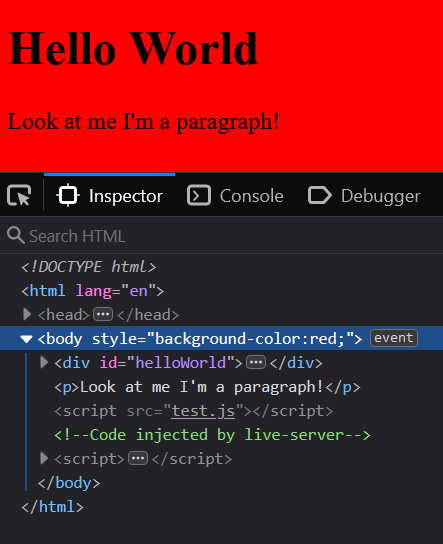
This example was all done with what is called a function. A function is a set of instructions that is told to the browser when it has been activated. Only once this function has been activated will the events transpire.
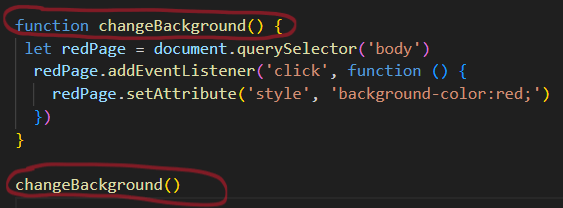
In our example we can see at the top I have declared the function as ‘changeBackground’ with content within it. On the very last line I have activated the function by typing in the code changeBackground() within the Javascript code. What this will mean is as soon as the website is loaded, this function will already be running, and the chain of events should be happening. It was only now waiting for me to click my mouse button on the screento start the next piece of instructions. The click of the mouse button then sparks another function, this was to turn the background color to red. So really, using functions is just like having a chain of events happen based on your given instructions when you request for them to happen or when you designed it to activate.
Let’s also look at what is called control flow. Control flow is essentially the order of which the code is being run. In most cases code is run from top to bottom. However, with javascript the control flow can be dependant on when the code is being told to run. Javascript might initially be reading code from top to bottom, like how we read a book. But using something like a loop can disrupt the flow. The control flow will change. A function at the bottom of your page can callback functions at the top of your page. It’s quite flexible. Think of it like reading a book that has the added feature of being a ‘pick your own adventure’ type of feature where after reading the page, you’re asked to choose an option and flip to page x. In this case the control flow is not giving an option, it’s forcing the code to jump pages, backwards or forwards depending on your code. This can be seen in a loop very clearly. Loops will continue to run the code until it is told to stop. The batch of code will run top to bottom, top to bottom as many times as its been told.
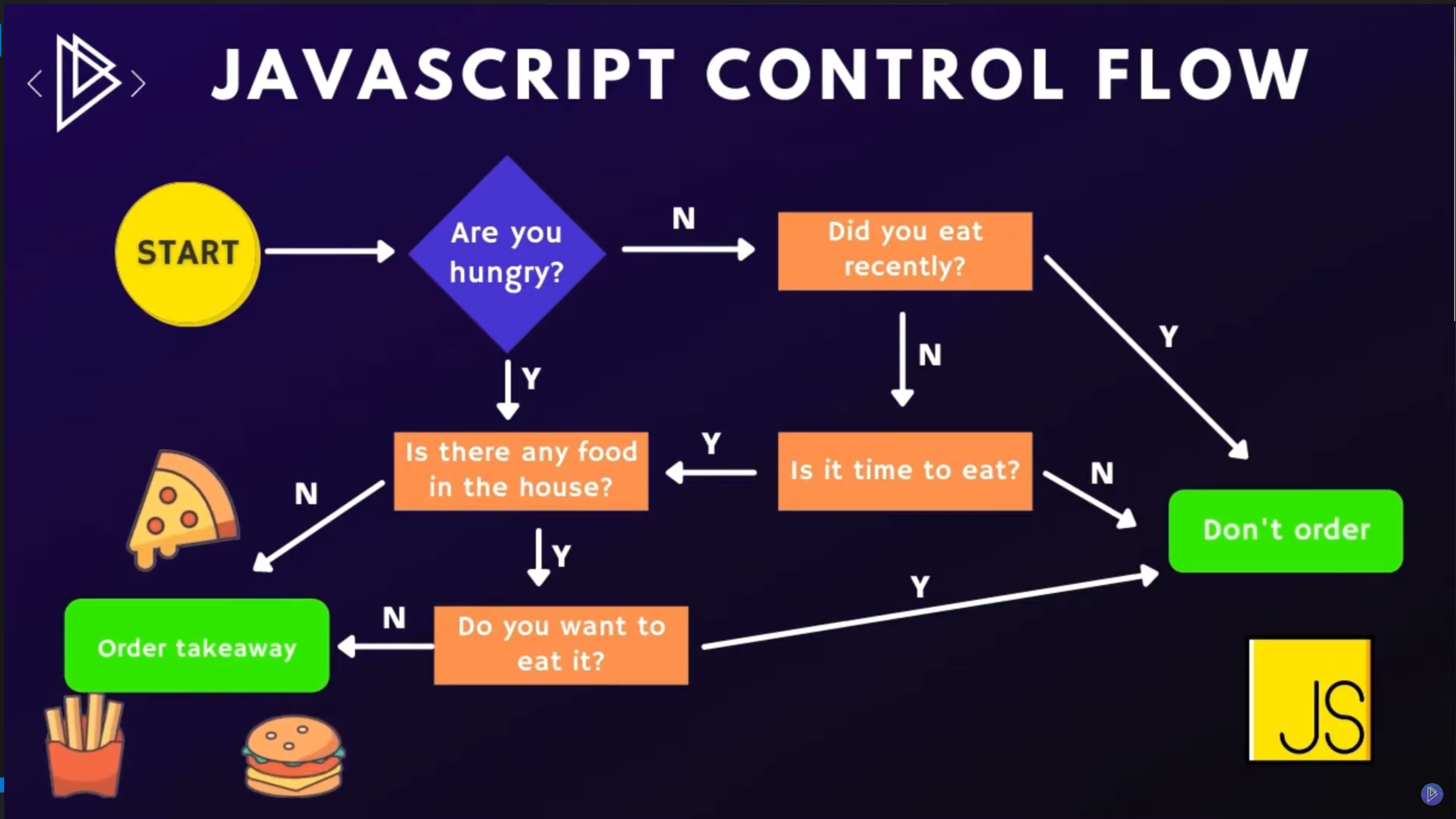
We also can’t forget objects and arrays. These are two different types of data storing mechanisms. Objects store keys with values and arrays simply store values. To me it makes sense to store data as an object if you plan to have multiple properties in said object. For example you could add in the name of a person and their age and when you attempt to access the variable in your browser, it will show you the properties and the values of the properties. See examples below.
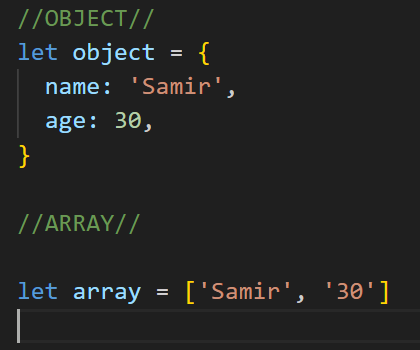
The object has two properties, one for name and one for age. Both have their own values attached to it and can be accessed as a whole or individually. If you want to just access the objects name and find out what it is you could type in console.log(object.name) and that will show you ‘Samir’

On the other hand arrays are very simple. The array has an index that starts at 0, this index is for the values that are stored in the array. For example our array above shows that there are two values ‘Samir’ and ‘30’. You can once again access these values individually or altogether. If you want to access the entire array you can simply say console.log(array) and it will print out in the console

If you want to access the ‘30’ in the array you can type in console.log(array[1]) to see the contents come up in the console.

These are just some of the fundamental components of Javascript. There are a lot more but unfortunately my knowledge only goes so far at this current point. Fortunately, this gives me a lot of room to grow and knowing that I have these fundamentals on hand will surely help me understand Javascript just that tiny bit better.